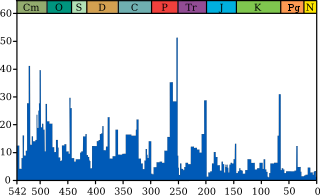 W
WAn extinction-level event is a widespread and rapid decrease in the biodiversity on Earth. Such an event is identified by a sharp change in the diversity and abundance of multicellular organisms. It occurs when the rate of extinction increases with respect to the rate of speciation. Estimates of the number of major mass extinctions in the last 540 million years range from as few as five to more than twenty. These differences stem from the threshold chosen for describing an extinction event as "major", and the data chosen to measure past diversity.
 W
WThe Alvarez hypothesis posits that the mass extinction of the dinosaurs and many other living things during the Cretaceous–Paleogene extinction event was caused by the impact of a large asteroid on the Earth. Prior to 2013, it was commonly cited as having happened about 65 million years ago, but Renne and colleagues (2013) gave an updated value of 66 million years. Evidence indicates that the asteroid fell in the Yucatán Peninsula, at Chicxulub, Mexico. The hypothesis is named after the father-and-son team of scientists Luis and Walter Alvarez, who first suggested it in 1980. Shortly afterwards, and independently, the same was suggested by Dutch paleontologist Jan Smit.
 W
WThe Andromeda–Milky Way collision is a galactic collision predicted to occur in about 4.5 billion years between the two largest galaxies in the Local Group—the Milky Way and the Andromeda Galaxy. The stars involved are sufficiently far apart that it is improbable that any of them will individually collide. Some stars will be ejected from the resulting galaxy, nicknamed Milkomeda or Milkdromeda.
 W
WThe Cretaceous–Paleogene (K–Pg) extinction event, also known as the Cretaceous–Tertiary (K–T) extinction, was a sudden mass extinction of three-quarters of the plant and animal species on Earth, approximately 66 million years ago. With the exception of some ectothermic species such as the sea turtles and crocodilians, no tetrapods weighing more than 25 kilograms survived. It marked the end of the Cretaceous period, and with it the end of the entire Mesozoic Era, opening the Cenozoic Era that continues today.
 W
WThe Eltanin impact is thought to be an asteroid impact in the eastern part of the South Pacific Ocean during the Pliocene-Pleistocene boundary around 2.51 ± 0.07 million years ago. The location was at the edge of the Bellingshausen Sea 1,500 km (950 mi) southwest of Chile. The asteroid was estimated to be about one to four km in diameter and the impact would have left a crater approximately 35 km (22 mi) across.
 W
WThe giant-impact hypothesis, sometimes called the Big Splash, or the Theia Impact, suggests that the Moon formed from the ejecta of a collision between the proto-Earth and a Mars-sized planetesimal, approximately 4.5 billion years ago, in the Hadean eon. The colliding body is sometimes called Theia, from the name of the mythical Greek Titan who was the mother of Selene, the goddess of the Moon. Analysis of lunar rocks, published in a 2016 report, suggests that the impact may have been a direct hit, causing a thorough mixing of both parent bodies.
 W
WThe Late Heavy Bombardment (LHB), or lunar cataclysm, is a hypothesized event thought to have occurred approximately 4.1 to 3.8 billion years (Ga) ago, at a time corresponding to the Neohadean and Eoarchean eras on Earth. During this interval, a disproportionately large number of asteroids are theorized to have collided with the early terrestrial planets in the inner Solar System, including Mercury, Venus, Earth and Mars. Since 2018, the existence of the Late Heavy Bombardment has been questioned.
 W
WThe Nibiru cataclysm is a supposed disastrous encounter between the Earth and a large planetary object that certain groups believed would take place in the early 21st century. Believers in this doomsday event usually refer to this object as Nibiru or Planet X. The idea was first put forward in 1995 by Nancy Lieder, founder of the website ZetaTalk. Lieder describes herself as a contactee with the ability to receive messages from extraterrestrials from the Zeta Reticuli star system through an implant in her brain. She states that she was chosen to warn mankind that the object would sweep through the inner Solar System in May 2003 causing Earth to undergo a physical pole shift that would destroy most of humanity.
 W
WThe Permian–Triassic extinction event, also known as the P–Tr extinction, the P–T extinction, the End-Permian Extinction, and colloquially as the Great Dying, formed the boundary between the Permian and Triassic geologic periods, as well as between the Paleozoic and Mesozoic eras, approximately 251.9 million years ago. It is the Earth's most severe known extinction event, with up to 96% of all marine species and 70% of terrestrial vertebrate species becoming extinct. It was the largest known mass extinction of insects. Some 57% of all biological families and 83% of all genera became extinct.
 W
WTheia or Orpheus (Ορφεύς) ) is a hypothesized ancient planet in the early Solar System that, according to the giant-impact hypothesis, collided with the early Earth around 4.5 billion years ago, with the resulting debris gathering to form the Moon.